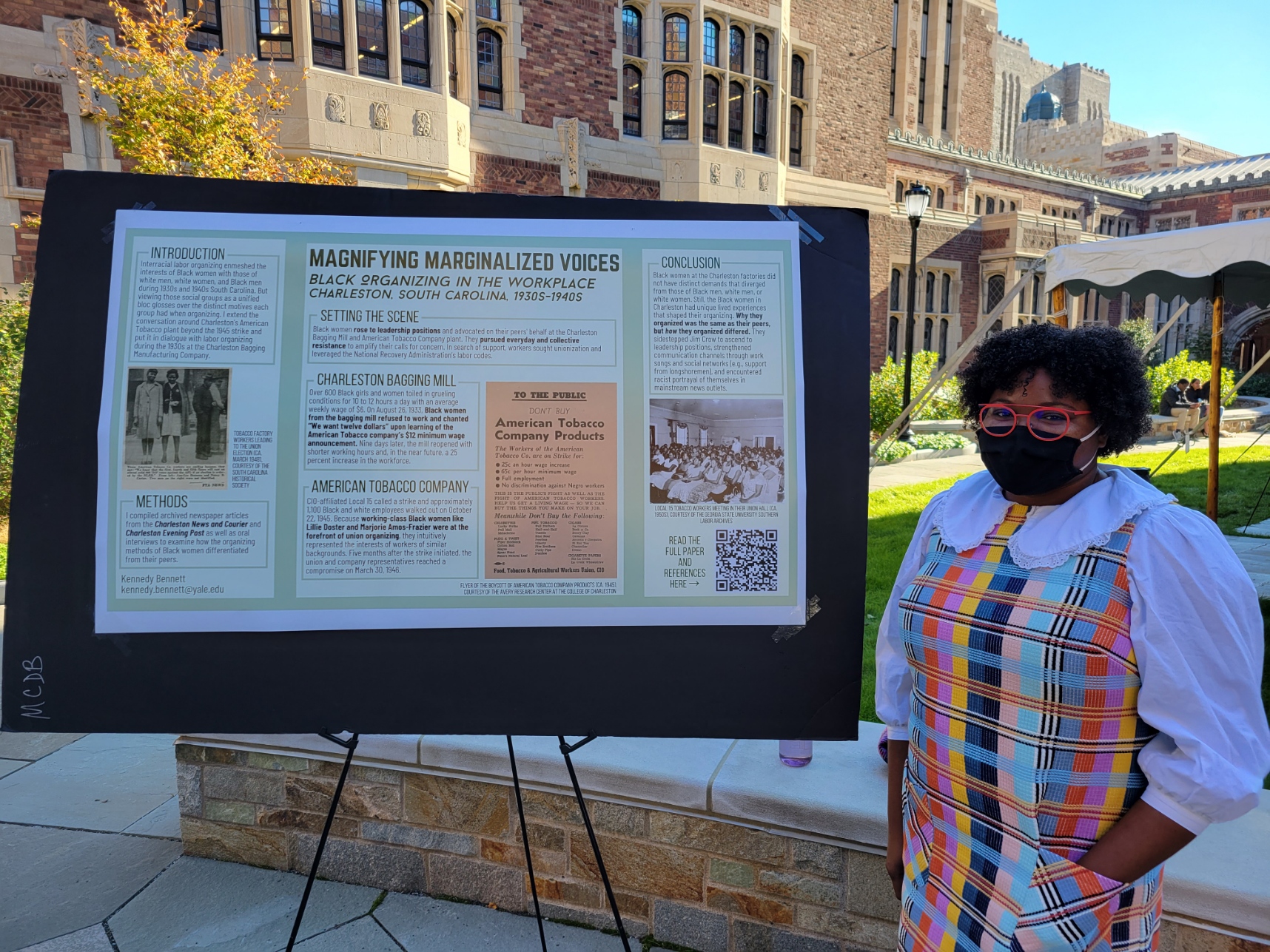YURA Fall Symposium showcases undergraduate research
Yale undergraduates presented research on an extensive range of topics to visitors in the Humanities Quadrangle courtyard on Saturday.

Carter Dewees, Contributing Photographer
The Yale Undergraduate Research Association’s Fall Symposium took place on Saturday, with more than a dozen undergraduates presenting their research to visitors in the Humanities Quadrangle courtyard.
The mission of the symposium was to “celebrate and award excellence in student research,” according to YURA. Topics on posters placed throughout the courtyard ranged from analysis of satellite imagery in California to translations of ancient Roman texts.
At the symposium, Kennedy Bennett ’22 presented her research — an in-depth analysis of Charleston newspaper archives titled “Magnifying Marginalized Voices: Black Organizing in the Workplace.”
“[Reporters] would interview police, factory management, white union leaders and they would characterize the Black women in animalistic ways, and sort of minimize, trivialize the reasons why they were on strike,” Bennett said.
Bennett, a history major, focused on Charleston, South Carolina in the 1930s and 40s. She combed through newspaper archives of the Charleston News, the Courier and the Charleston Evening Post, researching the history of labor organizing in tobacco factories and textile mills, two industries which heavily employed Black women in the 30s and 40s.
In 1933, workers at the Charleston Bagging Mill went on strike, leveraging policies set in place by President Franklin D. Roosevelt’s National Recovery Administration (NRA) program. In response, the bagging mill expanded its workforce and reduced hours for laborers, Bennett explained.
“Why [Black women in Charleston] organized was the same as their peers, but how they organized differed,” Bennett’s poster said.
According to Bennett, she identified the differences by filling in gaps of information from the articles she read due to their heavy bias towards union leaders and policemen.
Raymond Zhao ’22, an earth & planetary sciences major, researched the scale of solar farm production in the Imperial Valley in California and its effects on the region. By using satellite imagery collected every two years since 2011, Zhao analyzed the construction of a solar farm in the southwest region of the valley and the effect it had on the region. A primary takeaway from his analysis was that the solar farms were built on agricultural land, leading to less agricultural production in the southwest part of the valley. Zhao used a Normalized Difference Vegetation Index (NDVI) for this analysis.
On his poster, Zhao showed a decrease in NDVI over two-year intervals as solar panels were built.
“If you look at things regionally, there’s already evidence of change,” Zhao said. “For example, in the southern region where most of the panels are, NDVI has started decreasing, meaning that there’s less agriculture.”
He found that 89 percent of solar farms built in the area replaced agricultural land, and that solar farms were responsible for 17 percent of the decrease in agricultural land in the region. Zhao analyzed temperature data as well, noting an increase in temperatures where the panels were located. Zhao explained that the farms can be extensive, in this case about 15 kilometers wide. Zhao concluded that more research is needed on the effects of solar farm development on land use, vegetation productivity and land surface temperature in the Imperial Valley.
Charnice Hoegnifioh ’24 researched the history of makeup during a program named “Summer Research Opportunities at Harvard” along with Harvard professor Irene Peirano Garrison. Hoegnifioh’s presentation, titled “The Price of Beauty is Pain: Makeup and Women’s Health in the Roman Empire,” explores the origins of makeup and its place in ancient societies.
“For me, [makeup] is like a form of self expression, and I love the artistic element that comes with it,” Hoegnifioh said. “However I know makeup has not always been a form of self expression for women and makeup has been used for thousands of years.”
Hoegnifioh’s interest in the research is grounded in her academic interest as a pre-med student as well as her gender identity. She translated ancient texts, uncovering old uses of cosmetics.
Hoegnifioh’s analysis centered around ancient perspectives on makeup from male authors. Makeup was viewed as a tool for women to hide their external features from society and men, she found, which raised questions of their moral integrity among ancient male authors. Hoegnifioh explained that this language is interrelated with suggestions of witchcraft among ancient male authors. White lead was known as a poisonous material in ancient times, yet women still applied it to their faces to conform, a trend that Hoegnifioh said continues to this day.
“Women are still using these poisons [PFAs] on their faces as makeup, and these ideals and conceptions of beauty and being able to obscure and conceal your imperfections are being valued over individual female health and safety,” Hoegnifioh said.
The Yale Undergraduate Research Association was founded in 2015.







